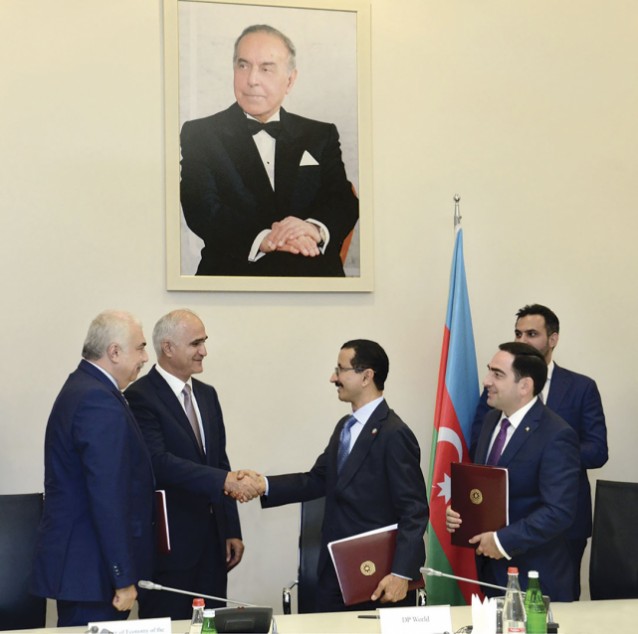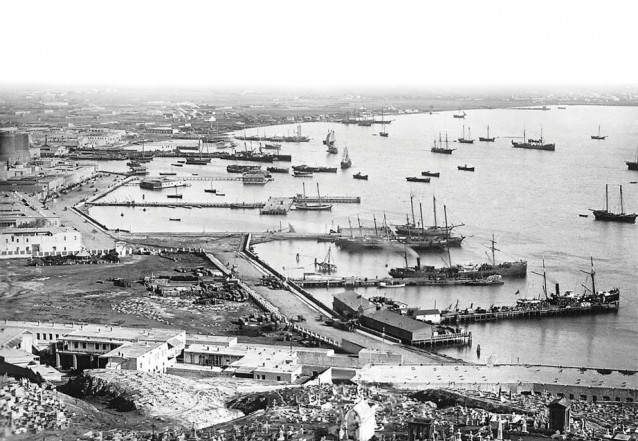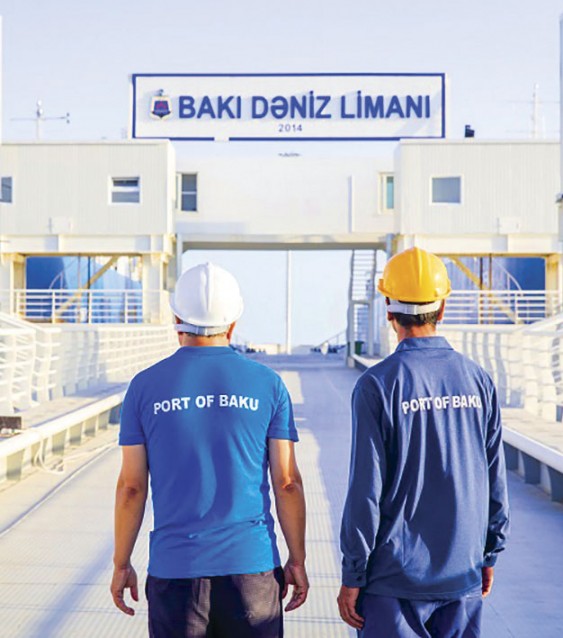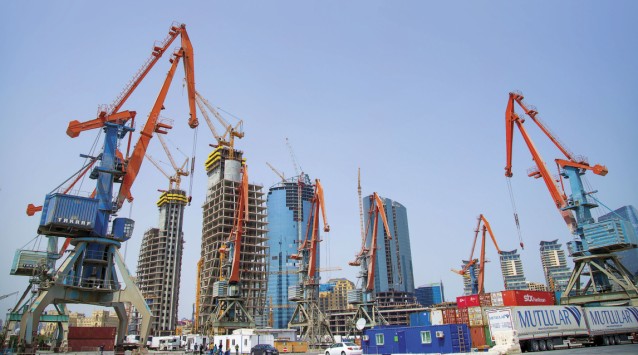The Caspian Sea has long been a trading hub and Baku - a bridge on both the great Silk Road and the North-South trade routes connecting Northern Europe to the Middle East and Asia. Central to this has been the Port of Baku, which is currently undergoing a major facelift.
The first modern Port of Baku was built in the mid-19th century and grew to become one of the Russian and then Soviet empire’s leading ports, playing a crucial role in particular in World War II. It was located at the eastern end of the Seaside Boulevard throughout the 20th century but due to space limitations, congested roads and plans to remove heavy industry from the city centre and develop the waterfront, a decision was taken in 2007 to build a new port at Alat (Ələt), some 70 km south of Baku.
All roads intersect in Alat
For centuries several Azerbaijani cities were located along the ancient Silk Road and caravanserais in cities such as Sheki and Shamakha acted as small trade hubs between East and West. In a similar way the ambitious new Port of Baku, officially called the Baku International Sea Trade Port, aims to provide a land link between China and Europe, particularly in light of the former’s ambitious One Belt, One Road trade initiative, described recently by the Seatrade Maritime News as:
the world’s largest economic corridor with a combined population of 4.4bn and economic output of $21trn, representing 40% of global GDP.
Currently cargo from China travels via Russia or Kazakhstan’s port of Aktau and on to Europe largely by sea, despite the fact that this takes 40 days as opposed to 12 by land. Few would have thought that the little-known coastal town of Alat might be the missing link, but in reality the town is considered ideally placed along the various road, rail and sea transit routes connecting Russia, Iran, Central Asia, the Black Sea and Turkey, most notably the Baku-Tbilisi-Kars railroad and the North-South transport corridor. As the director-general of the Port of Baku, Taleh Ziyadov, recently pointed out: All roads intersect in Alat.
 DP World, the Port of Baku and the Azerbaijani Ministry of Economy sign contracts on 7 September. From left to right: Niyazi Safarov, Deputy Minister of Economy; Shahin Mustafayev, Minister of Economy; Sultan Ahmed Bin Sulayem, CEO of DP World; and Taleh Ziyadov, Director-General of Port of Baku
DP World, the Port of Baku and the Azerbaijani Ministry of Economy sign contracts on 7 September. From left to right: Niyazi Safarov, Deputy Minister of Economy; Shahin Mustafayev, Minister of Economy; Sultan Ahmed Bin Sulayem, CEO of DP World; and Taleh Ziyadov, Director-General of Port of Baku
The new port is currently being constructed in three phases. The first phase began with the opening of a ferry terminal in September 2014 at a ceremony attended by Azerbaijani president Ilham Aliyev. On 3 August this terminal received the first test container block train from western China, which arrived in just six days. Two docks are currently operating and two more will begin by the end of the year (from a planned 11 overall). Phase one is scheduled to finish in 2017. When phases two and three begin is not yet clear, but, according to the port’s website, by the end of the third stage the new port should be able to handle 25 million tonnes of cargo and one million TEU (Twenty foot Equivalent Unit) in containers (10 - 11.5 million tonnes and 40-50,000 TEU at the end of phase one).
The overall cost of all construction phases was quoted by 1news.az as approximately 870 million AZN. Part of this will go towards acquiring state of the art facilities and equipment and ensuring the port meets ‘green’ standards through waste reduction programmes, special green zones and by reducing its carbon footprint. Plans have also been voiced to build a new international airport nearby in Alat to handle freight from the port and to serve passengers wishing to fly to the south of Baku rather than the north.
From the government’s perspective, the Port of Baku project is key to diversifying the economy and developing the non-oil sector. While energy and tourism are already well established, the new port aims to take advantage of the country’s advantageous location by maximizing its capacity for trade and transit. There is an added political incentive too: while the country’s successful oil strategy was the brand of former president Heydar Aliyev, Port of Baku and the ever-evolving transit and trade strategy is the brand of current president Ilham Aliyev.
Freeing up trade on the Caspian
A key element in this will be the creation of a special trade zone, following a decree by President Aliyev passed in March this year. Whether this will be a free trade zone or a special economic zone is currently undecided, but it will certainly be on the territory of the new Port of Baku in Alat. The aim of the zone is to attract investment and business and to make the Port of Baku not just an alternative but a necessity for businesses, according to Mr Sultan Ahmed Bin Sulayem, CEO of the UAE-based DP World, who added that this was what the company was able to do in Dubai.
Mr Sulayem was speaking at a contract signing ceremony between the Azerbaijani government, the Port of Baku and DP World, the world’s third largest port operator, which will advise on the free trade zone at the port in Alat. The ceremony was the result of six months’ work since the initial presidential decree. Much has been done, said Mr Sulayem, but there is still a long road ahead. Over the next six months DP World, which benefits from previous experience in the region, having advised on the port of Aktau and the Khorgos Special Economic Zone in Kazakhstan, will advise on establishing the necessary legislation, drawing up a master plan of the zone’s territory and carrying out a feasibility study. But Mr Sulayem felt confident that the special trade zone would be successful, especially given Azerbaijan’s development over the last twenty years:
If I showed you a picture of the country 20 years ago and a picture of how it is now, you wouldn’t believe it, he stressed.
The area of the port is approximately 400 hectares, 100-115 of which will be used for the creation of the special trade zone. The precise nature of the special economic regime is yet to be finalized but it is expected that the government will apply a number of tax, customs, tariff and other incentives in order to attract leading European and Asian companies and facilitate business between them, in a similar way to DP World’s flagship Jebel Ali Freezone in Dubai. Conditions will make it advantageous for international transport, logistics, storage and packaging and a host of other companies to operate in the region, giving a much-needed push to the Azerbaijani non-oil sector as well as the local economy in Alat.
Summarising DP World’s commitment to the project, Mr Sulayem explained:
We want to turn Baku into a coordination centre of Eurasia. We believe that you have the necessary components for this – the technology and resources. And we have the experience.
Beginning in 2017
The first meeting of the special trade zone’s working group in July focused on improving legislation and infrastructure, developing an economic rationale and development concept and discussed management of the zone and its future business activities. Negotiations with foreign companies are underway, DP World is bringing its trade and logistics expertise to the project and according to the port’s general director, Mr Ziyadov, major companies have already been attracted to invest, including from the US. In addition, a delegation from the European Bank of Reconstruction and Development visited Baku in May, as a result of which the organisation is reportedly considering investment. Chinese investors are likely to be very interested too. Overall, Mr Ziyadov has said, the special trade zone may be able to attract up to $1 million in just the first few years.
A bill on the special trade zone is expected to be tabled for discussion in the Milli Mejlis (Azerbaijani parliament) in autumn. If everything goes according to schedule then the zone will start operating in 2017.
The focus of the new Port of Baku is twofold: firstly to maximize Azerbaijan’s transit capacity, turning the Baku region into the foremost transport and logistics hub of Eurasia. But secondly, through the creation of a special trade zone, to revive the spirit of the old Silk Road by encouraging trade, investment and the merging of cultures. Currently 90 per cent of freight between Europe and Asia is delivered by water; in terms of a land connection Alat may just be the missing link.
For more on the new Port of Baku, see 21st Century Silk Road from the January-February 2015 issue.
About the author: Parviz Heydarov is an independent journalist specialising in economic analysis. Tom Marsden is the editor of Visions.




